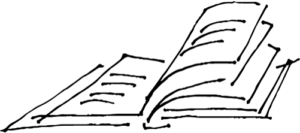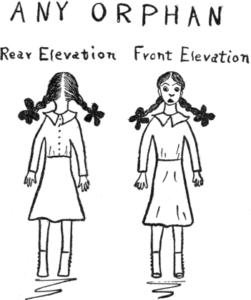
Sketch © Ellen Carnahan
Should there be illustrations in novels? My response? Of course there should! If we as a culture are moving from text-based articles to vlogs, from text-based books to audio books — and if many nonfiction works include illustrations as a matter of course, why should we omit visual enhancements from novels “just because”? At any rate, I have always loved illustrated fiction.
Ever since I was a little girl, I would spend hours studying the printed layout of classic books and how they looked overall. And I was always really enamored by those novels that included illustrations by the author.
Obviously one of the best examples is Tolkien, who was quite an accomplished map artist. [2025 Edit! I had always assumed that the maps in his books were his own. But I recently learned these were prepared for publication by his son Christopher. However he did draw the originals these were based on, so I think the point stands.] But there are others who are lesser known. One was an author named Jean Webster from the 1910s. Her illustrations seemed stylistically evolved from stick figures, yet they sprang to life on the page and brought great character to the reading.

From Daddy Long Legs © 1912 Jean Webster
She wrote at the turn of the last century, evoking the Victorian tradition that encouraged women to excel at sketching or painting, and where every invitation seemed hand crafted. The era that Alcott wrote about was not so far removed from Webster’s own.
There are some more recent examples, albeit still from the 20th century. James Thurber comes to mind, creating charming and humorous illustrations for magazines and his own works alike. Leaving aside non-fiction writers like David Macaulay and John Muir, children’s book author-illustrators such as Robert McCloskey and Sven Nordqvist, and the graphic novel genre as a whole, other well-known authors who illustrated their own books include such luminaries as Louise Fitzhugh, Antoine de Saint-Exupéry, T. S. Eliot, Kahlil Gibran, Rudyard Kipling, Lewis Carroll, Edward Lear, Günter Grass, William Blake, and Kurt Vonnegut. And that just scratches the surface.
I could not find any examples after the 1970s, and that’s a shame, IMO. Because it’s one of the things I like best about about some of my favorite works of fiction. And I think it’s time to bring that tradition back.
Express Yourself!
While I’m less accomplished at creating detailed illustrations, I have been officially perfecting my “casual” style for about a decade. When I look (way…) back at my portfolio from high school or grade school, my older pieces bear a strong resemblance to my sketches of today. In other words, while I may have some native talent, and while I have been deliberately honing it now for some time, all my drawings have something in common: they express my own energy, ideas, and views of the world. I don’t expect them to earn high accolades, but they are just as much a part of me as anything that I write.
My strongest motivation for including my own sketches in my debut novel (aside from being fond of them) is to encourage readers to express themselves — however raw or polished their style may be. Some might look at the illustrations in Dream Worlds and say, “those are pretty cute, and she’s not Picasso, but maybe I could do that too.” I want to encourage people to develop their own talent, without comparing themselves to anyone else. “Why can’t I pick up my pencil (or pen or tablet) and make a sketch I like and send it out there? Why shouldn’t I illustrate my own book?”
On a related note, how do you feel about authors who read their own audio books? My opinion is: if a writer wants to voice their own work, it should be encouraged. If you are publishing anything, either independently or through a traditional or hybrid publisher, and you want the original expression of your own voice to accompany your text, go for it! I have heard that some publishers may try to dissuade this practice — and so I pass on the best advice I’ve heard on the subject: you have the right to insist on it.
C Happy reading! D

Sketch © Ellen Carnahan